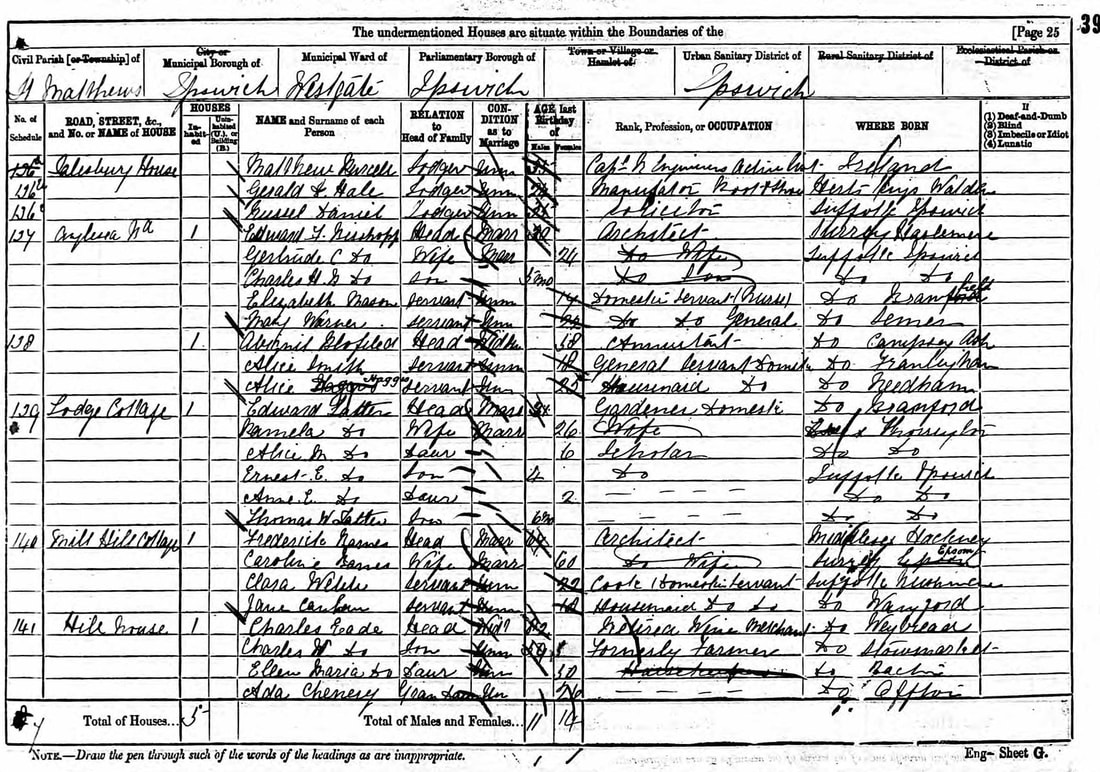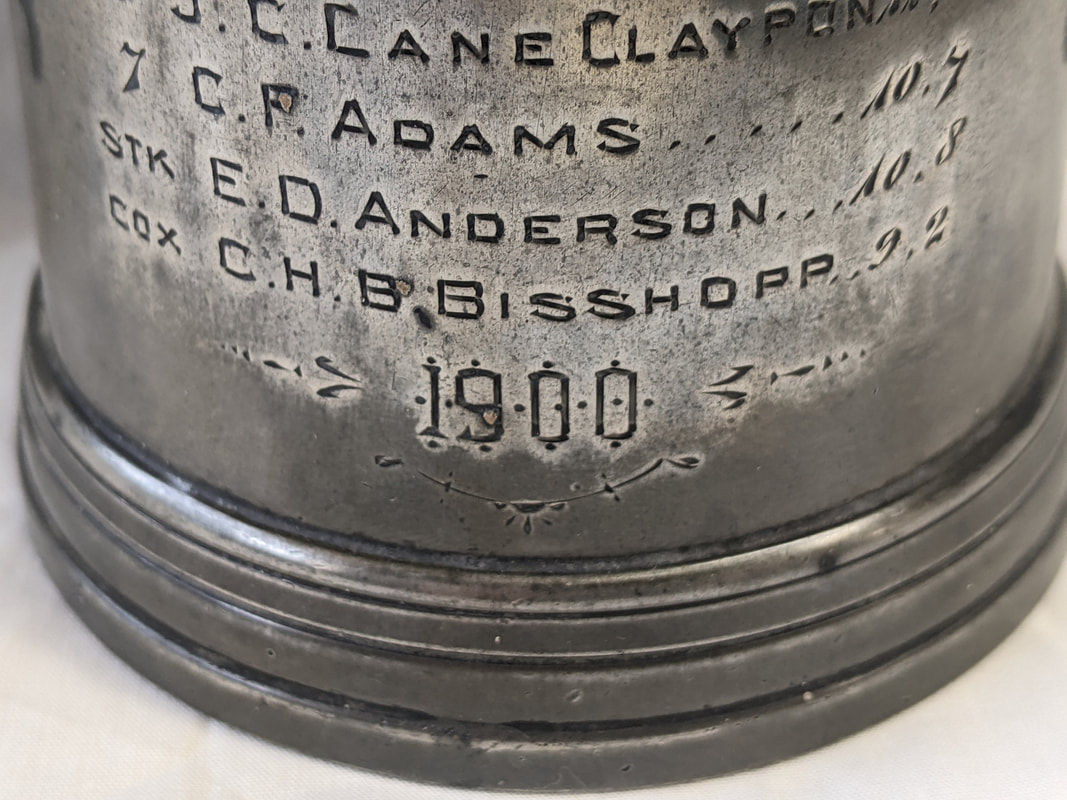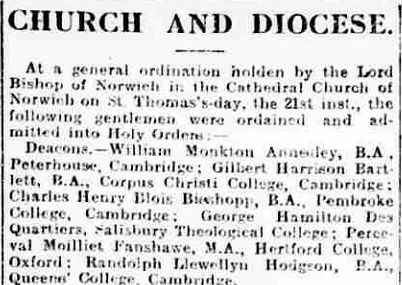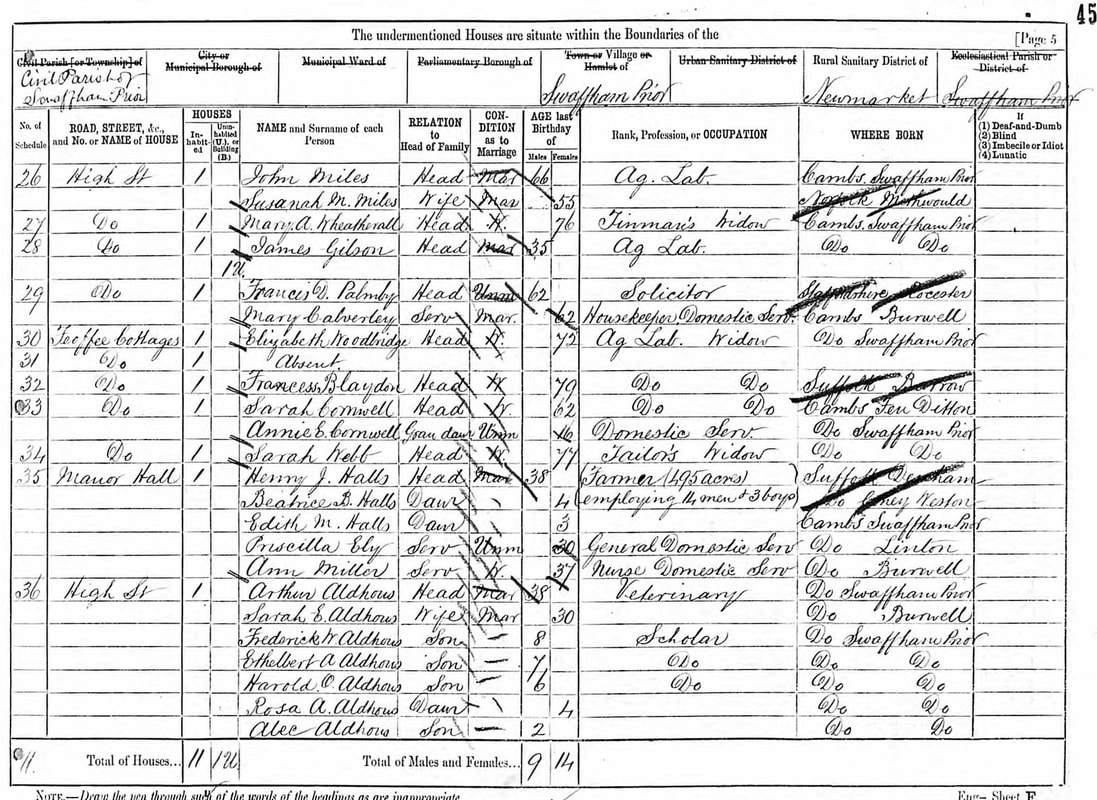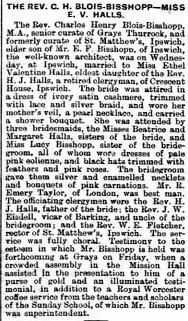Reverend Charles Henry Blois Bisshopp 1880-1952
All Saints Church 1917-1933
All Saints Church 1917-1933
Charles Henry Blois Bisshopp was born on the 17th October 1880. Charles’ parents were Gertrude Clementia and Edward Fernley Bisshopp, an Architect. Charles was 5 months old when the census for the following year, 1881, records that his family lived in Anglesea Road, Ipswich.
The 1891 Census shows the family had moved to ‘Haslemere,’ 8 Pine Villas, St Edmund's Road, Ipswich and Edward is an Architect and Diocesan Surveyor.
Joining Charles, now 10 years old, are siblings Lucy Gertrude aged 9, Edward Alfred Fernley aged 4 and Agnes Marion aged 1.
The 1891 Census shows the family had moved to ‘Haslemere,’ 8 Pine Villas, St Edmund's Road, Ipswich and Edward is an Architect and Diocesan Surveyor.
Joining Charles, now 10 years old, are siblings Lucy Gertrude aged 9, Edward Alfred Fernley aged 4 and Agnes Marion aged 1.

Charles was admitted to Pembroke College, Cambridge in 1899. The following year he was the cox of the Junior Rowing Team Eight. A tankard was engraved as a memento for each member of the team, giving the team’s names and weights. Charles weighed 9 stone 2oz and would have been approximately 20 years old. In 1902 he was awarded the degree of Bachelor of Arts (B.A.) and in 1906 he was created Master of Arts (M.A.)
|
With thanks to Kevin Skates for found the tankard and shared the images. The tankard was awarded to the Junior Rowing Team at Pembroke College in 1900.
The Rev Bisshopp was part of the rowing 8. The tankard records his weight in 1900 at 9 stone 2 oz. and he would have been around 20 years old. |
Charles was admitted into Holy Orders and ordained Deacon by the Bishop of Norwich on the 21st December 1905 in Norwich Cathedral.
From the Norfolk Chronicle and Norwich Gazette 23rd December 1905
From the Norfolk Chronicle and Norwich Gazette 23rd December 1905
Between 1905-8 Charles was curate of St Andrews, Ipswich. In 1908 he moved to Grays, Essex, where he became senior curate. Kelly’s Directory for the area shows Charles as living at 16, Sherfield Avenue, Grays, Essex.
The following year, 1909, Charles married Miss Ethel Valentine Halls. When Ethel was born in April 1874 her parents Henry and Katherine living in Coney Weston, Suffolk, were farmers. During their marriage Henry and Katherine had six children, three sons and three daughters, Charles Farrow, Frederick John Harry, Bernard Walter, Beatrice Bevington, Edith Margaret and Ethel Valentine.
As a farmer of 495 acres and employing 14 men and 3 boys according to the 1881 census, Henry decided to take Holy Orders. Newspaper reports show him as Licentiate in the church and Parish priest in 1888. The 1891 census records Henry as a clerk in Holy Orders at The Vicarage, Wiggenhall St. Mary’s, Denham, Norfolk. At the same address in 1901, he was named Clergyman, Church of England. In 1891 Ethel was attending High School in Kings Lynn and other records show that in later life her three brothers went on to have a career in banking and her two sisters remained unmarried.
The following year, 1909, Charles married Miss Ethel Valentine Halls. When Ethel was born in April 1874 her parents Henry and Katherine living in Coney Weston, Suffolk, were farmers. During their marriage Henry and Katherine had six children, three sons and three daughters, Charles Farrow, Frederick John Harry, Bernard Walter, Beatrice Bevington, Edith Margaret and Ethel Valentine.
As a farmer of 495 acres and employing 14 men and 3 boys according to the 1881 census, Henry decided to take Holy Orders. Newspaper reports show him as Licentiate in the church and Parish priest in 1888. The 1891 census records Henry as a clerk in Holy Orders at The Vicarage, Wiggenhall St. Mary’s, Denham, Norfolk. At the same address in 1901, he was named Clergyman, Church of England. In 1891 Ethel was attending High School in Kings Lynn and other records show that in later life her three brothers went on to have a career in banking and her two sisters remained unmarried.
Some time between 1901 and 1911 Ethel’s family moved to 3, Crescent Road, Ipswich. As Charles was also in this area before he moved to Grays it is quite possible he was introduced to Ethel at this time.
Charles and Ethel were married on Wednesday 28th April 1909. The Essex County Chronicle for the event records that Ethel wore a dress of ivory satin cashmere, trimmed with lace and silver braid. She had three bridesmaids, her two sisters Beatrice Bevington and Edith Margaret and Charles’ sister Lucy.
The officiating clergy included Ethel’s father, Rev. H. J. Halls, Charles’ uncle the Rev J. W. Eisdell, vicar of Barking, and Rev. W. E. Fletcher, rector of St Mathews, Ipswich. Charles was 28 years old and Ethel 34 years old.
The officiating clergy included Ethel’s father, Rev. H. J. Halls, Charles’ uncle the Rev J. W. Eisdell, vicar of Barking, and Rev. W. E. Fletcher, rector of St Mathews, Ipswich. Charles was 28 years old and Ethel 34 years old.
|
The Essex County Chronicle also recorded, ‘Testimony to the esteem in which Mr. Bisshopp is held was forthcoming at Grays on Friday, when a crowded assembly in the Mission Hall assisted in the presentation to him of a purse of gold and an illuminated testimonial, in addition to a Royal Worcester coffee service from the teachers and scholars of the Sunday School of which Mr. Bisshopp was superintendent.
|
Sometime after their marriage, according to the 1911 Census, Charles and Ethel’s home was ‘Ilfracombe’ Highview Avenue, Grays, Thurrock, Essex. Ethel’s brother Bernard was also living close by in Grays.
A move to Watford was made in 1912 when Charles became curate at Christ Church, St Albans Road, where he remained until 1917. The area, although very close to the town of Watford, still retained much of its rural aspect. At this time, as with many towns and villages up and down the country, families were experiencing a huge loss of men killed in WW1. Charles would no doubt have been close to many of the families, supporting them through these difficult times.
The Rev. Edward Wells, vicar of All Saints church had first hand experience of the war having left for France in June 1916 for three months. This led him to apply for a Chaplaincy in the army on his return and this was successful. He wrote in the Parish Magazine for December 1916 that he would be leaving Croxley Green on 10th December. Charles was offered the opportunity to take over. He became the new vicar on Saturday 3rd March 1917 and he and Ethel made the Vicarage, Watford Road their new home.
A move to Watford was made in 1912 when Charles became curate at Christ Church, St Albans Road, where he remained until 1917. The area, although very close to the town of Watford, still retained much of its rural aspect. At this time, as with many towns and villages up and down the country, families were experiencing a huge loss of men killed in WW1. Charles would no doubt have been close to many of the families, supporting them through these difficult times.
The Rev. Edward Wells, vicar of All Saints church had first hand experience of the war having left for France in June 1916 for three months. This led him to apply for a Chaplaincy in the army on his return and this was successful. He wrote in the Parish Magazine for December 1916 that he would be leaving Croxley Green on 10th December. Charles was offered the opportunity to take over. He became the new vicar on Saturday 3rd March 1917 and he and Ethel made the Vicarage, Watford Road their new home.
As with the previous vicars and their families, Charles and Ethel would continue to be included in many of the village activities. The war was seeing a rise in the number of men killed in action, and as they did in Watford, Charles and Ethel would also support the families in Croxley Green in need of comfort for their losses.
Charles would also be aware of the support the village as a whole required, especially at Sunday morning services when he would announce any recent news from the Front to the families and on how the men were coping, as well as the dreadful news of more fatalities.
Any help that could be provided such as knitted garments were sent from the church groups. With the numbers of men who had enlisted and the fatalities from Croxley Green increasing since 1914, Charles suggested that they should be recorded. A wooden shrine was erected in the churchyard on Sunday 29th July 1917 with a special service. At that time 320 men’s names were added in remembrance of those who had left the village.
Charles would also be aware of the support the village as a whole required, especially at Sunday morning services when he would announce any recent news from the Front to the families and on how the men were coping, as well as the dreadful news of more fatalities.
Any help that could be provided such as knitted garments were sent from the church groups. With the numbers of men who had enlisted and the fatalities from Croxley Green increasing since 1914, Charles suggested that they should be recorded. A wooden shrine was erected in the churchyard on Sunday 29th July 1917 with a special service. At that time 320 men’s names were added in remembrance of those who had left the village.
Following the announcement on 11th November 1918 that Germany had surrendered, the village began to think about how to commemorate the lives of those men who had died.
The tradition of planting an oak tree on The Green to celebrate major events had started in the reign of Queen Victoria. H.T. Wilson -‘Neggy’ (Headmaster of the boys’ school) along with other residents suggested a Memorial oak to mark the occasion. The villagers raised the money for a suitable oak tree from Berkhamsted by purchasing special little lapel button badges. The tree was blessed at a service by Charles in the church, and then carried to the designated site on The Green, opposite New Road. On Sunday afternoon 2nd November 1919 the tree was duly planted by ex service men. In attendance also was the Rev Donnell and Rev Edward Wells, both former vicars at All Saints.
The tradition of planting an oak tree on The Green to celebrate major events had started in the reign of Queen Victoria. H.T. Wilson -‘Neggy’ (Headmaster of the boys’ school) along with other residents suggested a Memorial oak to mark the occasion. The villagers raised the money for a suitable oak tree from Berkhamsted by purchasing special little lapel button badges. The tree was blessed at a service by Charles in the church, and then carried to the designated site on The Green, opposite New Road. On Sunday afternoon 2nd November 1919 the tree was duly planted by ex service men. In attendance also was the Rev Donnell and Rev Edward Wells, both former vicars at All Saints.

The Memorial Oak was planted on Sunday afternoon 2nd November 1919 followed later by large granite blocks that were later obtained from the John Dickinson mill and placed together in front of the tree with the names of those who had lost their lives. Protective railings with a gate were erected to deter passing cattle from damaging the young tree.
A two minute silence in Cape Town, South Africa, had been taking place daily at noon from May 1918 with the firing of guns to Pause in Remembrance of their war dead. The idea eventually reached King George V who approached the War Cabinet for approval of a similar two minutes silence that would take place on the first anniversary of the Armistice at 11am on the 11th November 1919.
In subsequent years on 11th November at 11am a 2 minutes silence continued, as well as a special Remembrance service on the Sunday closest to this day.
Large granite blocks were later obtained from the John Dickinson mill and placed together in front of the tree with the names of those who had lost their lives. Protective railings with a gate were erected to deter passing cattle from damaging the young tree. Cows were still grazed on the Green or were herded daily from the fields near the Sarratt Road to a milking parlour on Scots Hill.
John Dickinson’s mills also erected memorials on their sites, including Croxley Green. The Croxley memorial was unveiled on the 8th December 1922 by R H Ling, Managing Director and dedicated by Charles as vicar of All Saints’ church.
In subsequent years on 11th November at 11am a 2 minutes silence continued, as well as a special Remembrance service on the Sunday closest to this day.
Large granite blocks were later obtained from the John Dickinson mill and placed together in front of the tree with the names of those who had lost their lives. Protective railings with a gate were erected to deter passing cattle from damaging the young tree. Cows were still grazed on the Green or were herded daily from the fields near the Sarratt Road to a milking parlour on Scots Hill.
John Dickinson’s mills also erected memorials on their sites, including Croxley Green. The Croxley memorial was unveiled on the 8th December 1922 by R H Ling, Managing Director and dedicated by Charles as vicar of All Saints’ church.
Slowly the village began to recover and Charles’ duties within the church and village regained normality including baptisms, marriages and funeral services. However, following the war, changes to fashions were now taking place, and in particular to wedding outfits. In the December 1928 edition of the Parish Magazine Charles had written his views and comments on how bridesmaids should appear at the wedding ceremony in church, and this was picked up by at least one newspaper.
From the Derby Daily Telegraph 7th December 1928
Charles was quoted as saying “A wreath of flowers around the head is not a sufficient covering in church. Bridesmaids should have proper covering on their heads such as a hat or veil.”
In an interview with a reporter, Mr Bisshopp said, “The custom of women wearing hats and men removing theirs in the Christian Church goes back for about 2,000 years to the preaching of St Paul …. in my opinion it is just as bad for a woman to enter a church with her head uncovered as it would be for a man to enter with his hat on.”
In an interview with a reporter, Mr Bisshopp said, “The custom of women wearing hats and men removing theirs in the Christian Church goes back for about 2,000 years to the preaching of St Paul …. in my opinion it is just as bad for a woman to enter a church with her head uncovered as it would be for a man to enter with his hat on.”
A particular responsibility for Charles would have been the two schools in Yorke Road and Watford Road, which at this time were church schools. He would make visits on a regular basis, ensuring that the children were given proper religious instruction, and testing their knowledge of the Bible. Charles was also concerned about the state of the schools, both in need of enlarging and also refurbishment.
With the increasing numbers of children in the village, Charles along with others overseeing the management, felt a separate mixed senior school was required.
This did eventually lead to the opening of Durrants School in 1939 by Herts County Council.
Charles would have had a great deal of input for having the Berean Cottages demolished, now below living standards. They were replaced by a new church hall in November 1932 by the Arch Deacon of St Albans. This would become an important asset for the church community.
With the increasing numbers of children in the village, Charles along with others overseeing the management, felt a separate mixed senior school was required.
This did eventually lead to the opening of Durrants School in 1939 by Herts County Council.
Charles would have had a great deal of input for having the Berean Cottages demolished, now below living standards. They were replaced by a new church hall in November 1932 by the Arch Deacon of St Albans. This would become an important asset for the church community.
An entry in the Parish magazine for August 1932 Charles indicates that he and Ethel have their annual holiday in East Anglia where they had both spent their earlier years, prior to coming to Hertfordshire.
Croxley Green in the early 1930s was experiencing yet another huge expansion of house building, mainly due to the Metropolitan Railway Line that had by then reached out to the area. Charles and his wife Ethel, some six years older, may have felt that now was the time to move back to the quieter areas of the East Coast and away from the increasing pace of life in Croxley Green. So in October 1933 Charles and Ethel made the decision to leave Croxley Green, their home for sixteen years and join her family, who were now living in Gorleston-on-Sea, near Great Yarmouth, Norfolk.
According to the 1919 Electoral Roll and 1921 census, Ethel’s parents Henry and Katherine and her sisters Edith and Beatrice had moved to 8 Park Road, Gorleston-on-Sea, Norfolk, just a few hundred yards from a quiet sea front and sandy beaches.
When Charles and Ethel decided to join them they lived at 6, Park Road. Charles was the priest in charge of the St. Andrews church, Gorleston, from 1933-36 and then vicar of St Mary’s, Southtown, Great Yarmouth.
According to the 1919 Electoral Roll and 1921 census, Ethel’s parents Henry and Katherine and her sisters Edith and Beatrice had moved to 8 Park Road, Gorleston-on-Sea, Norfolk, just a few hundred yards from a quiet sea front and sandy beaches.
When Charles and Ethel decided to join them they lived at 6, Park Road. Charles was the priest in charge of the St. Andrews church, Gorleston, from 1933-36 and then vicar of St Mary’s, Southtown, Great Yarmouth.
Sadly Ethel died in 1936 on the 20th February, aged 61, and was buried in Gorleston Old Cemetery.
According to the 1939 Register Charles continued at the same address, 6 Park Road, with Evelyn Sidney as his housekeeper and Ethel’s family still resided at 8 Park Road.
The following year Charles’ housekeeper Evelyn, aged 56, died on 25th November 1940 in the City Hospital, Nottingham, whilst on a visit to her brother Algernon who lived in Nottingham.
According to the 1939 Register Charles continued at the same address, 6 Park Road, with Evelyn Sidney as his housekeeper and Ethel’s family still resided at 8 Park Road.
The following year Charles’ housekeeper Evelyn, aged 56, died on 25th November 1940 in the City Hospital, Nottingham, whilst on a visit to her brother Algernon who lived in Nottingham.
In 1942 Charles married Hilda Marie Ninham, born 11th May 1891, who lived locally with her parents and family at 1, Avondale Road, Gorleston, also close by to the sea front. Hilda was the daughter of Henry and Laura, and older sister to Ivy and Henry Ninham. The family had lived in Belaugh, Norwich prior to moving to Gorleston. The 1939 Register shows Hilda’s occupation was an Arts & Crafts worker.
Hilda’s father Henry William had taken over from his father Henry Christian’s Baking Powder business in Norwich, but was now retired.
(Ninham’s (est.1870) a local producer of traditional Norfolk cake mixes. Each cake mix made according to traditional recipes, with no artificial additives, preservatives, colourings or salt used in them.
It was originally Henry Christian Ninham who went into the cake baking business going on to establish the National Works of Ninham & Son, Baking Powder Manufacturers, situated at the top of Ber Street in Norwich. He produced a range of cake mixes, successful in Norwich, but also across the rest of the country.
In 2011, Ninham’s collaborated with the Colman’s Mustard Shop and Museum to create two exclusive scone mixes, which incorporate Colman’s Double Superfine mustard powder, and their exclusive Tarragon and Thyme mustard powder.
It was originally Henry Christian Ninham who went into the cake baking business going on to establish the National Works of Ninham & Son, Baking Powder Manufacturers, situated at the top of Ber Street in Norwich. He produced a range of cake mixes, successful in Norwich, but also across the rest of the country.
In 2011, Ninham’s collaborated with the Colman’s Mustard Shop and Museum to create two exclusive scone mixes, which incorporate Colman’s Double Superfine mustard powder, and their exclusive Tarragon and Thyme mustard powder.
After a relatively short marriage to Hilda, Charles Henry Blois Bisshopp aged 72 years died on the 29th December 1952 and is buried in Gorleston Old Cemetery with his first wife. Taken from the All Saints church Parish Magazine for January 1953 and indicates the reason why Charles and Ethel, his first wife decided to leave Croxley Green as she was unwell. Charles had suffered with 'physical infirmities' before he passed away too
Hilda did not remarry after the death of her husband Charles She was 95 years old when she died on the 15th March 1987 in Milton Lodge Retirement Home, 290 Ipswich Road, Colchester, Essex, the address given in the Probate Records. She was buried in St Barnabas churchyard, Great Tey, a village on the outskirts of Colchester.
Information found from Genealogy websites,
Ancestry
Find my past
Family search
My Heritage
Also
The Croxley Green All Saints church Parish Magazines 1915/16/32
Croxley Green in the First World War - Brian Thomson (2014)
Wikipedia


